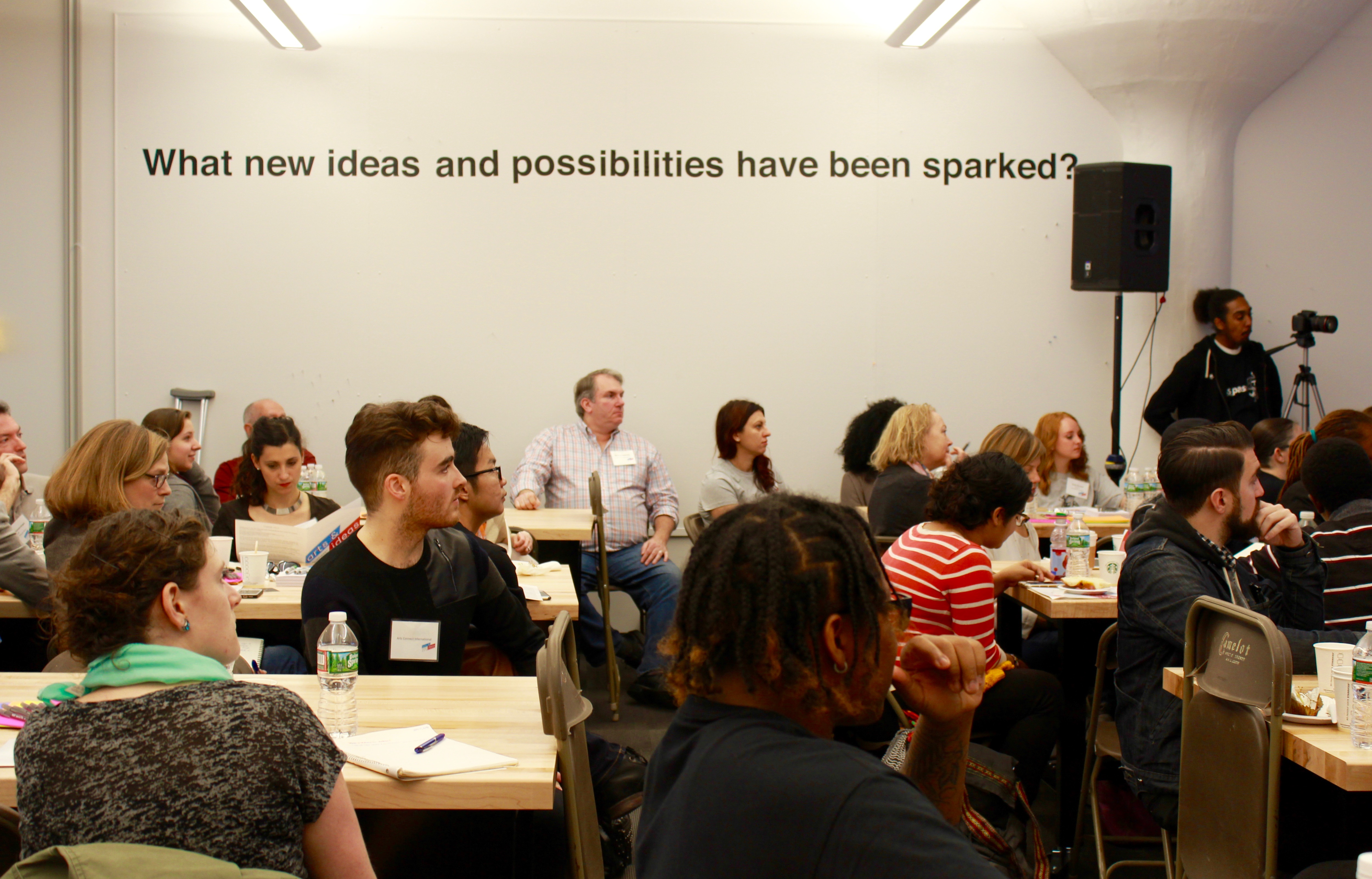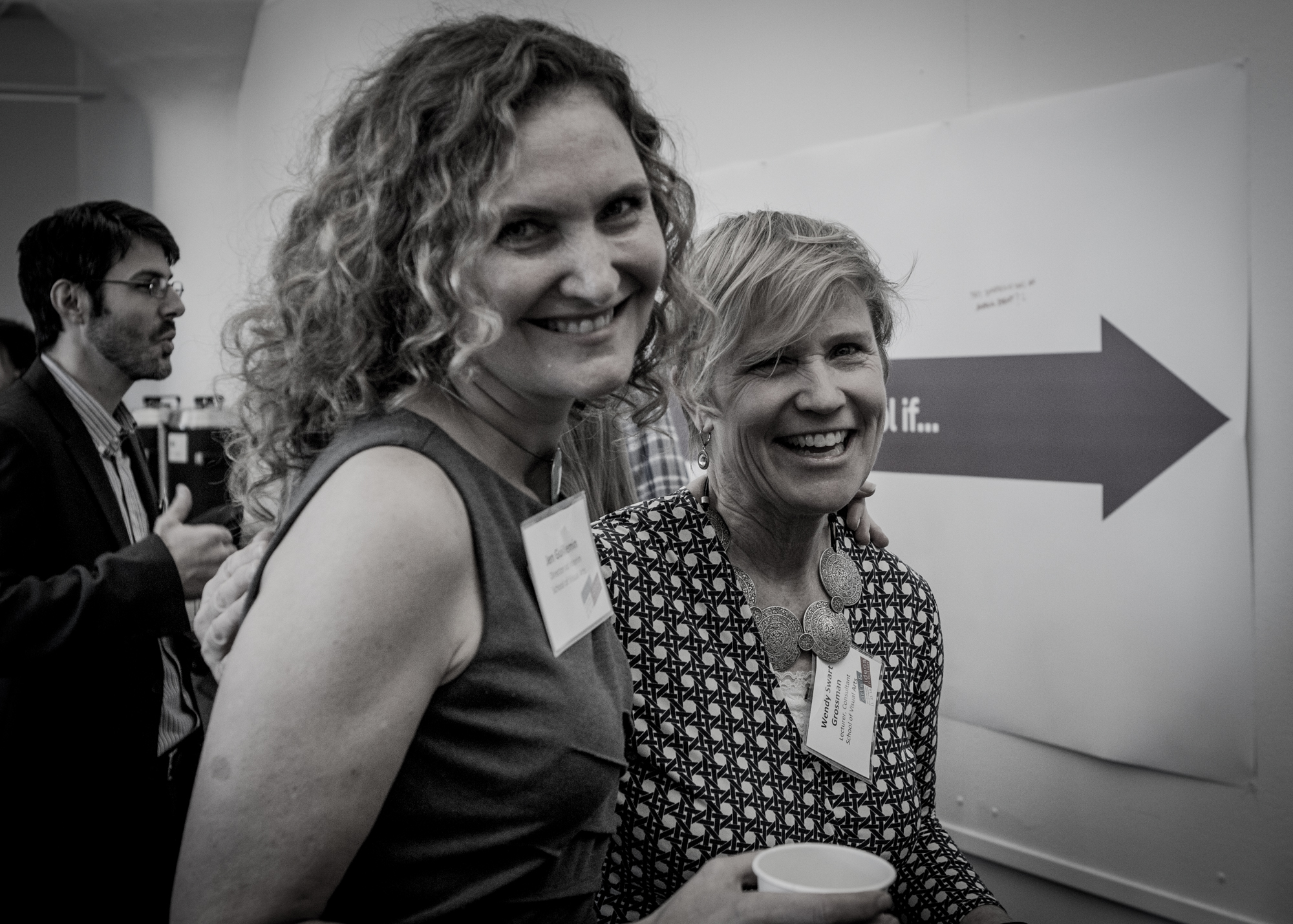Summary
Creativity in its many forms is integrated into the tapestry of greater Boston -- from the Rose Kennedy Greenway to the innovation districts in the Boston Seaport and Dudley Square, to the universities and arts organizations throughout the city. Social impact work-spaces, incubators, accelerators, and makerspaces expand opportunities for artists and creative professionals to work with biotech, technology, healthcare, design, and higher education to address societal issues.
Creative Placemaking, the intentional action of cross-sector partners fueled by arts and culture, is gaining ground as an effective way to build and sustain communities. Regional and national reports by the New England Foundation for the Arts and Americans for the Arts further quantify the billions of dollars generated by the creative economy and university arts programs can play an important role as an engine for change. To further explore this rich intersection of arts, commerce, and social impact, Boston University’s College of Fine Arts (CFA), the Questrom School of Business, and the BU Arts Initiative came together to launch the symposium: Arts and Ideas in Action: Art + Business + Social Impact. Held on November 11, 2016, this innovative event has become a data point for the importance of cross-disciplinary collaboration and was featured at the Global Consortium of Entrepreneurial Centers 2017 Conference in Nova Scotia.
The symposium invited university faculty, students, and staff as well as nonprofit and for-profit professionals to engage in a cross-disciplinary conversation reflecting on the question, “How do we create stable economic opportunities while building vibrant communities and addressing societal needs?”

Compelling Interactive Dialogue Encourages Engaged Participants.
Photo Credit: Hannah Goff Spicher
Building a Framework
After co-designing and teaching both Cultural Entrepreneurship for graduate students, and Creative Economy and Social Impact for undergraduates at Boston University, the lecturers and authors of this paper designed the symposium to expose students and the greater community to leaders working at the intersection of arts, commerce, and social impact.
The symposium employed the 4V Assessment Model (Kuhlke, Schramme, Kooyman, p. 247) conceived by the authors as a framework for innovative projects. Each of the 4V’s (Vision, Venture, Viability, Vitality) represents a key aspect needed to implement intentional, impactful initiatives.
V1, Vision. For any entrepreneurial initiative to be a success a clear vision is imperative. In this case, the vision was to showcase and explore a variety of economically successful models of businesses working in the creative industries, committed to social impact and community vitality.
The vision also included the commitment to ensure a cross-disciplinary representation of attendees from Boston University’s faculty, staff, and students along with practitioners and leaders from the for-profit and nonprofit communities.
V2, Venture. The venture is the manifestation of the vision, and in this case, it was the symposium. Intentional elements were integrated into the fabric of the Arts & Ideas in Action Symposium ensuring its success, including:
1. Diverse Panelists. Each one of the six carefully selected presenters gave a five-minute/20 slide Ignite Style presentation. The presenters, both male and female, came from different ethnic backgrounds and spoke to entrepreneurial thinking in nonprofit, for-profit, and B Corporation settings. While the presenters were dynamic and engaging for the attendees, the organizers ensured there was ample time for the panelists to network amongst themselves and collaborate both pre- and post- symposium.
2. Compelling Interactive Dialogue. Participants were purposefully assigned tables that included students, faculty, and practitioners. Each table had colored paper, markers, and cards, and networking was encouraged amongst the participants. Student volunteers were assigned to the tables and interspersed throughout all the activities to ensure that all participants felt comfortable, welcomed, and engaged. In addition, questions were posted on the walls lining the large gathering rooms and participants were encouraged to post bright colored notes with questions, thoughts, and ideas.
3. Cross–Disciplinary Participation. Particular classes within each one of the 17 BU colleges were targeted to ensure participation from both the faculty and students. Personalized, warm and thoughtful invitations were emailed prior to the registration being available online to the general public to ensure a curated representation. Organizers met with professors to solidify student participation and to ensure meaningful programming.
4. Design Thinking Workshops. In an effort to deepen ties between BU and nonprofit and for-profit companies, Graphic Design faculty offered Design Thinking workshops with students in the afternoon sessions addressing the community partners’ real issues. This promoted thoughtful dialogue and on-going relationships to amplify the social impact goals of each organization.
5. Intentionality with Budgetary Decisions. Each transaction offered opportunities to express the vision and form strategic partnerships. For example, the nonprofit organization Transformative Culture Project (TCP) who works with inner city youth to teach storytelling through video production was employed to film the event. Along with the $1,200 fee that covered the hourly wages of the high school students to film and edit the footage, the relationship between BU and TCP grew. The TCP students were invited to come to BU at a later date to tour the facilities and meet with admissions professionals. You can see the finished three-minute video here: https://www.youtube.com/watch?v=qn7aJrhvCzA
V3, Viability. The viability of a venture relies on healthy streams of income. The three BU partners (CFA, Questrom School of Business, and Provost’s Arts Initiative) each contributed funds to underwrite the conference costs so it could be offered for free to all attendees. The symposium was held in the newly renovated CFA’s Graphic Design Studios and was an opportunity to showcase the program at no additional cost.
Given the shared cost and high impact, the Deans of both the College of Fine Arts and Questrom School of Business were excited to lend their support and both were on stage to welcome the 150 participants.
30 student volunteers set the welcoming and engaging tone as they helped with wayfinding, assisted with registration, and acted as greeters and conversationalists.
V4, Vitality. Vitality is the “secret sauce” that distinguishes this initiative and makes it special. From the moment the 150 participants arrived, they were made to feel welcomed. From African drums playing upon arrival, to proceeding down corridors with sound installation music and exhibited student paintings, to being invited into conversation over coffee and croissants and to writing on interactive design boards -- participants knew they were in a creative space that would encourage dynamic thinking and ideas generation.
Call to Action
Building on the national trends of increased public and private sector work around Creative Placemaking, the timing is ripe for cross disciplinary collaboration. It is through these unique partnerships that thoughtful idea generation happens. Through strategic partnerships, arts and business leaders can work together to “create stable economic opportunities while building vibrant communities and addressing societal needs.”
Applying the 4V Model as a framework for building well-conceived, entrepreneurial events with a social impact is one that is encouraged. It is at the edges -- when unlikely partners join forces -- that true innovation takes place. As shared by writer Anne Fadiman, “I have always felt that the action most worth watching is not at the center of things but where edges meet. I like shorelines, weather fronts, international borders. There are interesting frictions and incongruities in these places, and often, if you stand at the point of tangency, you can see both sides better than if you were in the middle of either one.”
Arts and culture will continue to serve as a valuable strategic partner in Boston, and universities can lead the way of linking disparate partners to work together toward positive social change.
Works Cited:
Anne Fadiman, The Spirit Catches You and You Fall Down (Farrar, Straus and Giroux, 1997).
Olaf Kuhlke, Annick Schramme, Rene Kooyman (ed), Creating Cultural Capital (Chicago, University of Chicago Press, 2015), p 247.
Economic and Public Policy Research Group, UMass Donahue Institute, Jobs in New England’s Creative Economy and Why They Matter (Boston, New England Foundation for the Arts, 2017).
Americans for the Arts, Arts & Economic Prosperity 5: The Economic Impact of Nonprofit Arts & Culture Organizations & Their Audiences (Washington DC, Americans for the Arts, 2016).
Author Bios

The authors Jeannette Guillemin and Wendy Swart Grossman
Photo Credit: Nicole O’Connor
Wendy Swart Grossman
Wendy Swart Grossman, in addition to lecturing at BU, is a nonprofit and foundation
social impact consultant. With a background in presidential politics in the U.S. and South Africa, she brings a creative mindset, strategy, and the ability to build and leverage effective partnerships. She holds a bachelor’s degree in Economics and Political Science from St. Olaf College and a master’s in Urban and Environmental Policy from Tufts University.
Jeannette Guillemin
Jeannette Guillemin, lecturer and director ad interim for the BU School of Visual Arts, creates and implements collaborative and experiential programming that expands professional opportunities, ignites entrepreneurial thinking, and engages student artists within the Boston community. She holds a bachelor’s degree in English (creative writing) from the State University of New York at Geneseo and master’s degrees in both Arts Administration and Counseling from Boston University.


